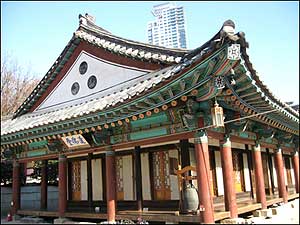
|
|
|
Home Asia Pacific North Asia S/N Korea History & Archaeology Bongeun Temple: Downtown Temple Aged Over a MillenniumBy Jang Eun-hwa, The Korea Times, Dec 21, 2007Seoul, South Korea -- "A millennium-aged downtown temple'' is the common epithet that reminds us of Bongeun Temple in the heart of Gangnam area, one of the most prosperous district in Korea. In the middle of November the temple celebrated its 1,213th anniversary. In the jungle of contemporary skyscrapers where modern man is busy struggling to live, lies the temple like an oasis for thirsty city-dwellers.
Making my way through the forest of high-rises, I arrived in front of Jinyeo Gate, the main gate of Bongeun Temple, on a refreshing weekday in December. Here, ``Jinyeo'' means ultimate truth, so it is a gate leading to the Jinyeo world of the Buddha. The gate looks like a boundary between modern and ancient, noisy and calm, war and peace, separation and unity. The gate, unlike other traditional temples, has in it another one the gate of Four Guardians. The guardians, whom Buddhists consider as protectors of the temple, used to be kings in heaven but became disciples of Buddha after being impressed by the Buddhist teachings.
Upon entering the temple I was overwhelmed by the sudden change of atmosphere from secular to sacred and made a vow to remove three poisons "greed, anger and delusion" from my mind. These days, I am especially interested in the historic structure that is among Bongeun Temple's many precious heritages the hall of Panjeon, a building in which Buddhist scriptures are kept. I slowly climbed the gentle slope toward Panjeon, and paused for a moment to contemplate on what has supported this temple for over a millennium, currently running an enterprising renovation project in an effort to harmonize tradition with modernity. Surviving a long history of ups and downs, the temple has suffered hardships during Joseon Kingdom (A.D. 1392-1910), which suppressed Buddhism in favor of Confucianism. During the harsh persecution, the Buddhists retreated into the depths of mountains; Buddhist monks were banned from entering the capital city; the number of authorized temples was reduced to around 250; and as a result, monks were commonly treated as lower class citizens. Despite the unprecedented suppression imposed on Buddhism at that time, Bongeun Temple, however, had the fortune to remain as the nation's leading temple through the effort of Queen Regent Munjeong and the national scholar, Ven. Bowoo. Bongeun Temple remained as ``the capital temple of Seon Buddhist sect,'' keeping a close relationship with the royal family that supported Buddhism privately but not publicly. By in the early 17th century, the temple was among the biggest temples, the compound of which extended several times more than that of today. Then it experienced the downfall of the Joseon Kingdom and Japanese occupation of Korea (A.D. 1910-1945), and furthermore lost most of its halls and pavilions in a fire in 1939, though renovated later. Amid Seoul's expansion and development of its southern part in the 1970s, the compound of Bongeun Temple was greatly reduced. But it still has remained until today as one of rare places where we can step on unpaved bare earth in the middle of concrete jungles. Today, Bongeun Temple has secured a high position in Korean Buddhism as a symbolic temple that provides a shelter for prayer and rituals for around 200,000 registered lay Buddhists, offering various relief work for the underprivileged, and representing Korean Buddhism to foreigners here and abroad. While pondering on the history of the temple, I arrived in front of the oldest structure of the temple. The wooden structure, Panjeon, literally ``the hall of Buddhist sutra blocks,'' was built to store the wooden blocks of 81 volumes of Avatamsaka sutra led by Ven. Yeonggi and calligrapher Chusa Kim Jeong-hee in 1855. The repository was a product of hi-tech science at that time and has already been proven to have surprising storing capability. Another structure having such purpose is Janggyeonggak in Haein Temple, South Gyeongsang Province, which has provided incomparable storing capacity for the Tripitaka Koreana for more than 700 years. What makes the hall of Panjeon even more famous than the hall itself are the two letters, ``pan'' and ``jeon'' in Chinese characters written on the hanging tablet. At first sight, the letters do not look nice at all, and it is not easy to believe it to be a work of the most prominent figure in calligraphy, poetry and painting throughout the whole Joseon Kingdom. The author, Kim, is said to have spent his last few years at Bongeun Temple, creating a lot of his masterpieces. In fact, he was also a devout lay Buddhist and honored as a master mentor for Buddhism. The letters on the board seem thoroughly lacking any skill and decoration that maestros usually display. It even looks as if the letters were written by a child who has just learned to write. Can the extremes of nadir and zenith meet? I stayed a while looking up the board intently and tried hard to understand the master's idea and life. What mystery is held in the simplicity reached by the artist? Located on the left side of the Panjeon is the Bongeun Meditation Center, where I practiced sitting meditation for about six months last year. The sight of the isolated meditation hall reminded me of my training days. In a large hall each practitioner would sit still on a thick cushion with his or her body facing the wall. The sound of Jugbi, or a bamboo clapper, gave the signal for the start of meditation. Then in a second, the hall was enclosed in complete silence. Neither sound nor motion could be perceived, except for the beams of sunlight pervading through the window. In contrast to the complete calmness of the outside, however, the inside of my mind was frequently quite the opposite. It took me some time to concentrate on my Hwadu, which is a question that evokes deep doubt of the mind, ultimately aiming to reach peace of mind. This kind of Buddhist meditation, called Hwadu-seon or Ganhwa-seon, originated in Tang Dynasty, ancient China, about 1,200 years ago. Ironically, it is not in China but in Korea that the tradition of Seon Buddhism has been preserved intact and established firmly as a distinctive feature of Korean Buddhism. Bongeun Temple, fitting for its reputation as ``the head temple of Seon Buddhism,'' is among the rare temples, which provide meditation space for the public. There lies an enormous parking lot in the spacious yard of the temple, seemingly accommodating to modern man but at the same time seriously damaging its traditional looks. Fearing the necessary evil of modern times would encroach upon the precious tradition, I sincerely anticipate a wise solution, which embraces the modernity and tradition by Bongeun Temple's committee in promoting the temple's designation as a historic park. ---------------------- |
 |
|
| Korean Buddhist News from BTN (Korean Language) |
|
 |
|
|
Please help keep the Buddhist Channel going |
|
| Point
your feed reader to this location |
|

 << Seonbuldang. The structure, first founded in 1562 and rebuilt in 1941, was originally a place for the selection of Buddhist monks, including Joseon’s eminent monks Ven. Seosan and Ven. Samyeong.
<< Seonbuldang. The structure, first founded in 1562 and rebuilt in 1941, was originally a place for the selection of Buddhist monks, including Joseon’s eminent monks Ven. Seosan and Ven. Samyeong.

